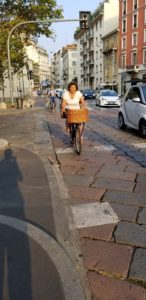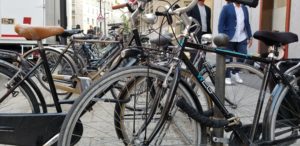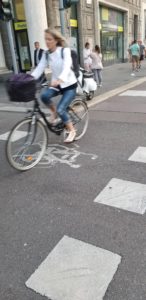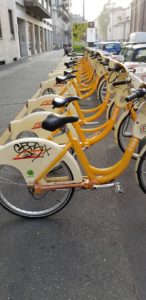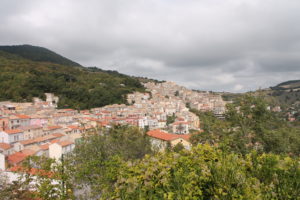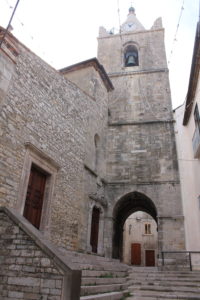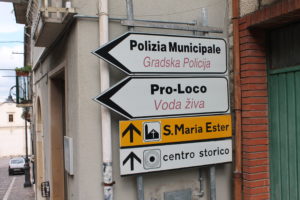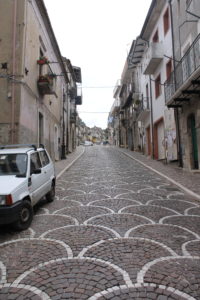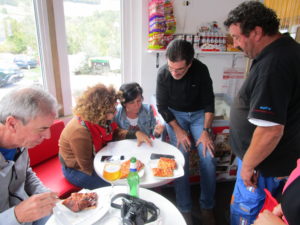(This is a column written by editors at the Tampa Bay Times, not by me.)
Jaime Ferguson should be dead. She was jogging across Tampa’s Bayshore Boulevard in a crosswalk when a truck ran a red light at 45 mph and hit her. The impact tossed her crumpled body 35 feet. She sustained a fractured skull, broken leg, torn rotator cuff, injured spine and $200,000 in medical bills. She’s not sure how she survived, and even years later has not fully recovered.
“I never thought I would be hit by a car,” she said.
Who does? Yet, for far too long, the Tampa Bay metro area has been one of the most dangerous places to walk in the United States. A pedestrian is far likelier to die in Tampa Bay than in much busier and much larger New York City — three times as likely when accounting for the Big Apple’s larger population. Three times.
In a typical year in Pinellas and Hillsborough counties, drivers hit more than 1,000 pedestrians. About 100 of them die. Those numbers include walkers and runners, not cyclists.
Pedestrians are involved in fewer than 3% of traffic crashes on local roads, but they account for nearly a third of all fatalities. It’s a stark reminder that pedestrians stand little chance when things go wrong.
The victims can be anyone — young and old, tourist and local, well off and less so. They can be someone you love.
Nineteen-year-old Isaiah Edward Baker Castellano enjoyed skateboarding; he died after a crane truck ran a red light and struck him on Pinellas’ Gulf to Bay Boulevard.
Nazire Blloshmi, 79, was killed while walking with a friend in Dunedin at what the mayor later described as a “funky intersection.”
A small SUV driver struck and killed Jeffrey Wilson, a 54-year-old physical educationteacher, as he strolled with his wife in downtown St. Petersburg.
All three of those victims were using crosswalks or the sidewalk.

Jeffrey Wilson, shown in this photo posted on the Freedom Elementary School Facebook page, was critically injured when he was hit by a car in downtown St. Petersburg, police said. [ Freedom Elementary School ]
Whether legally at fault or not, the drivers have to live with the fatal crash for the rest of their lives. Think about that the next time you’re tempted to send a text from behind the wheel or speed up to make a waning yellow light.
Yes, it can be hard as a driver to relate to some of the crashes. In Tampa a few years ago, a teenager sped at 100 mph on Bayshore Boulevard and slammed into a mother and her baby daughter, killing both. But most pedestrians are killed in more mundane ways. A moment of inattention. Driving too fast. Easy mistakes to make.
Many drivers either don’t know the laws about yielding to pedestrians or don’t care. People who would never run a red light routinely fail to give way to a pedestrian in a crosswalk. Others aren’t paying attention. Instead, they fiddle with their phones or take a bite of a sandwich, distracted just enough at just the wrong time to leave a pedestrian battered and broken on the asphalt.
Imagine the outcry if the Tampa Bay area were the murder capital of the country instead of one of the deadliest for pedestrians. The response would be immense, from more policing to new policies. The community would insist on swift and effective action. But in some years, Tampa Bay area murders barely outnumber pedestrian deaths. Whether killed by a bullet or a bumper, the person is still dead — due to a violent act.
Cars crashing into cars is bad enough, but it’s so much worse when a car hits a person. Just ask Ferguson. Ten years later, her near-death experience still prowls her memories. “I would close my eyes and see the car coming at me.”
What’s the problem?
To understand the depth of this problem and to probe for solutions, weanalyzed pedestrian deaths, talked to victims and their loved ones, consulted with experts and sought out officials who have found answers, including a city that ranked even worse than the Tampa Bay area for pedestrian deaths but did something about it. The carnage is not inevitable.
Making pedestrians safer will take changes in driver behavior, in road and vehicle design, and in how Tampa Bay law enforcement agencies educate the public and enforce the rules about crosswalks, yielding the right of way, distracted driving and speeding. Experts call them the four E’s: education, engineering, enforcement and evaluation. To work, they should be done together.

Signs mark a defunct pedestrian crossing on E Fletcher Ave. near N 15th St. in Tampa. [ DOUGLAS R. CLIFFORD | Times ]
Some of this is already happening, but it’s not enough. The number of maimed and dead pedestrians makes that clear. Drivers need to know the rules of the road, and governments must ensure they’re followed. The most basic one: Drivers yield to a pedestrian in a crosswalk, whether it’s marked or not. That’s the law.
Roads should be designed for safety, not speed. Whatever the speed limit says, a straight, wide road like Dale Mabry in Tampa encourages drivers to speed.
Surprisingly, well-designed streets with lower speed limits don’t have to lengthen a driver’s commute. Driving faster doesn’t always get you there faster. More on that later.
Tampa Bay’s worst roads for walkers
Here’s where drivers have killed the most pedestrians since 2008.
Each dot shows the site of at least one crash that killed a pedestrian from 2008 through 2022. Highlighted areas are those with the most crash locations within a 1-kilometer circle. Includes crashes in Hillsborough, Pinellas, Pasco and Hernando counties. Source: National Highway Traffic Safety Administration Fatality Analysis Reporting System
LANGSTON TAYLOR | Times
If police crack down on traffic violators, the number of crashes, injuries and fatalities will drop. And, as we’ll explain below, that doesn’t always mean police officers pulling over speeders.
The challenge in making streets safer isn’t just technical; it’s cultural and psychological. Driving can make even calm people angry. That problem is amplified here because Tampa Bay is so car-centric. That won’t change, not anytime soon. But attitudes toward pedestrians can — and should.
A recent run-in at a local intersection illustrates Tampa Bay’s challenge. At a four-way stop at the Snell Isle Bridge in St. Petersburg, one car zoomed through to turn right without stopping. Then two other drivers, both trying to turn left, entered the intersection at the same time, blocking one another in the middle. One honked at the other, and the other flipped him off. Neither moved.
Both claimed the right of way, yelling at each other but literally getting nowhere. One of us watched this unfold and noted the irony; none of the three cars had even considered stopping for a pedestrian in the crosswalk, which is the law.

Amy Cohen became a pedestrian safety advocate after her son Sammy was hit and killed. [ Families for Safe Streets ]
It isn’t like that elsewhere. We’ve seen it with our own eyes. In Hawaii, drivers more often yielded to pedestrians in a crosswalk, sometimes nowhere near a traffic light — even on a coastal highway. In Vancouver, Canada, drivers routinely stopped for pedestrians — on wide straight roads, on residential streets, in busy parks, in an alley behind an office tower, even for a visitor from Florida who once turned around mid-intersection after realizing he was headed in the wrong direction.
Sure, it’s the law, but it’s the law here, too. The difference is that places like Hawaii and Vancouver have more of a culture of watching out for pedestrians — and significantly lower pedestrian fatality rates. Tampa Bay does not, but it could.
When an official with the safety organization Vision Zero Hillsborough rented a car in Portland, Oregon, her nephew reminded her to yield to pedestrians — because that’s the law. It’s so top of mind there, she told us, that people tell visitors about it. Even though the law is the same in Florida, it’s hard to imagine that a Floridian would volunteer that safety tidbit to a visitor.
We can work toward that day, starting now. We need to know and follow the law, and police need to enforce it. When drivers start seeing other drivers following the law, slowing down and yielding to pedestrians, more of them will, too. The culture will improve.
Distracted driving, texting behind the wheel, speeding and ignoring rules of the road are often viewed as inevitable, something that can’t change. But we can make driving and walking safer in Tampa Bay. There was a time when few people wore seatbelts and drunken driving was no big deal. That changed. So can this.
Speed kills
We all know speeding is a problem in Tampa Bay, but here’s how bad: Two years ago, researchers found that nearly every driver sped through a school zone near Hillsborough’s Bloomingdale High School. Of the 7,310 vehicles tracked, 7,171 went at least 10 miles over the limit, according to the data collected by Blue Line Solutions, a traffic safety company founded by veteran law enforcement officers.
It’s ridiculous that nearly all drivers were going so much over the 20 mph speed limit — and in a well-marked school zone.
Higher speeds increase odds that a crash will maim or kill. A pedestrian hit at 32 mph has a 1 in 4 chance of dying, according to a report from AAA. At 42 mph, half the pedestrians can expect to die. Those are routine speeds on many of our roads. Forty-two mph may not even feel fast to a driver cocooned in a car, but that extra 10 mph is all that separates life and death.
Think of Jaime Ferguson out on her Bayshore run. She was young and fit and — by the raw realities of physics — lucky to live. Still, when she landed after being launched into the air, she saw people standing over her. “Holy shit, did I just get hit by a car?” she remembers thinking.
Paramedics had to cut her out of her clothes. She was unable to work for almost three months. It was a year before she could run without pain. “I will always have back injuries,” she said. For years after she was hit, she wouldn’t run through that intersection. When she finally did, she cried.

Jaime Ferguson, 44, stands at the fateful crosswalk on Tampa’s Bayshore Boulevard with her golden retriever, Blitz. This is where she sustained serious injuries —a broken leg, skull fracture, and concussion— after being struck by a vehicle that ran a red light at the crossing in 2014. [ DOUGLAS R. CLIFFORD | Times ]
It doesn’t help that 6 in 10 vehicles on Florida’s roads are trucks or SUVs. Their higher hoods create blind spots where drivers don’t see pedestrians. When they hit them, they tend to run them over rather than snowplow them onto the hood, lowering the pedestrians’ chances of surviving.
Even as drivers go faster and drive heavier vehicles, they’re paying less attention, distracted by their smartphones. It’s illegal to text and drive in Florida, but officers issue only about 17 texting-while-driving tickets a day across the state, according to data from the Florida Department of Highway Safety and Motor Vehicles. The law is riddled with exceptions and hard to enforce. A driver can simply claim he was doing something other than texting while holding his phone.
Last year, the Florida Legislature considered a bill to allow only hands-free phone use while driving, with a few exceptions. Studies show that any use of smartphones while driving is a distraction, but a hands-free law would have made law enforcement simpler and our roads safer. But the bill failed.
Our state leaders should try again this year, and this time, they should pass the bill. The state has to muster the political will to curtail the violence. And that’s what it is: violence. People are dying. The lucky ones are left with permanent injuries. Cracking down on distracted driving must be a priority. It’s well beyond time for state leaders to start leading on this issue.
Leverage technology
To save lives, law enforcement and our elected officials should embrace a proven tool: speed cameras. They make the roads safer for everyone: drivers, pedestrians and bicyclists.
Speed cameras are neither new nor rare. First deployed more than 30 years ago, at least 200 U.S. communities use them today, according to the National Conference of State Legislatures. They work by combining a sensor and a camera to record speeding cars. Law enforcement can calibrate the cameras to measure a particular speed. The camera records violators, which triggers fines for the registered owners
Speed kills, and recent studies show speed cameras have a long, successful record of slowing speeders down. Speed cameras reduced crashes by as much as 39% and fatalities by up to 68%, according to a study of data from thousands ofspeed camera sites in England, Scotland and Wales. In New York City, zones with speed cameras saw fatalities fall by 55%, according to a report from the National Association of City Transportation Officials.

A speed camera monitors traffic at a school zone on W. Lutz Lake Fern Road near McKitrick Elementary School, Martinez Middle School and Steinbrenner High School in Lutz. The cameras are on during arrival and dismissal times to curb speeding in school zones. [ DOUGLAS R. CLIFFORD | Times ]
In Montgomery County, Maryland, speed cameras reduced the number of drivers going more than 10 mph over the limit on residential streets by 70% compared with a similar community that didn’t have them, a study in the journal Traffic Injury Prevention showed. Even better, the percentage of drivers exceeding the limit by at least 10 mph declined by more than one-thirdon streets that didn’t even have cameras — just warning signs that they might be in use. Awareness works.
Speed cameras changed conditions in Albuquerque, New Mexico, which consistently ranks worse than Tampa Bay for pedestrian safety, according to the advocacy group Smart Growth America.
Police officers there saw a clear correlation between fewer traffic citations and more deaths, so they reversed course. Albuquerque set up speed cameras two years ago, leading to nearly a quarter-million citations.
“We simply had to do more about speeding,” said Mayor Tim Keller. “We said, fundamentally, we’ve got to change our behavior.”
While Albuquerque still struggles with too many pedestrian deaths, speed cameras have been “a huge tool to help slow down our drivers,” said Police Lt. Chris Patterson. Albuquerque officials note that a 10% reduction in speed can reduce the number of significant crashes by 19% and can reduce the number of fatal car crashes by a third.
The cameras also have been a force multiplier. While the cameras catch speeders, police can focus on other ways of keeping neighborhoods safe, including responding to 911 calls and dealing with violent crime.
“It would take more than 100 officers to staff the 17 intersections (that have speed cameras) 24/7,” Patterson said. “And officers would only be able to stop one driver at a time.”
No one enjoys a speeding ticket. But you know what’s worse? Visiting a loved one at the hospital. Or the morgue.
Law and order
Speed cameras are quick to deploy, can pay for themselves and, most importantly, can buy time and save lives, while other solutions that take far longer — designing safer roads, for instance — are engineered and built.
By setting the cameras at a reasonable speed, they avoid the “gotcha” of fining drivers for slipping a bit above the speed limit. In slower speed zones, a buffer of 5 mph would be fair. On faster roads, 8 mph or 10 mph could be more appropriate. Some cities go so far as to post signs warning drivers of the presence of a speed camera — alerting them to follow the law. For believers in law and order, it’s hard to argue against the logic; the cameras reinforce rules in a reasonable way to make streets safer.
The Republican-dominated Florida Legislature and Gov. Ron DeSantis appear to agree — at least a little. In 2023, lawmakers passed a bill to allow speed cameras in school zones. In discussing it, they underscored that speed cameras are a great tool to protect children. While the law helps, far more Tampa Bay pedestrians are killed outside of school zones. They deserve protection, too.
Those who argue that speed cameras are too much like Big Brother should remember how many cameras are already out there. Ring doorbells. ATMs. Cameras on bridges and roads that record traffic information. It’s a small step to allow them to make our roads safer and to force drivers to pay attention.
Another advantage: Speed cameras don’t discriminate by race or ethnicity. By taking a photo of only the license plate, the camera doesn’t know who the driver is, which eases fears of discrimination and “driving while Black.”

A group of Martinez Middle School students walk past a speed camera on W. Lutz Lake Fern Road while walking to school in Lutz. [ DOUGLAS R. CLIFFORD | Times ]
Cities can address concerns about targeting poorer or minority neighborhoods by continually analyzing crash and speed data to ensure a camera is needed at a location. The camera can be removed once drivers adhere to speed limits and crashes have significantly decreased.
The incentive should be to reduce speeds and make roads safer. To that end, contractors hired to install and operate speed camera systems should not earn more money based on handing out a higher number of citations. Success should be measured by the system making less money over time as drivers obey the speed limit.
What to do with the profits from issuing the tickets? Three ideas:
- Spend it all on improving street safety, including funding effective traffic education programs.
- Give it all to predetermined local charities.
- Return it to residents by lowering property or other taxes. Any of those solutions eases the temptation for politicians to use the money for pet projects.
The point is to protect people, not to impoverish them. And remember, the cameras only catch drivers who speed excessively.
Better by design
Zero pedestrian deaths should be our goal. Speed cameras will move us in the right direction, but they are only one tool. Another vital component is better roads. The deaths will continue without roads designed with everyone’s safety in mind — not just for getting cars somewhere as fast as possible. Engineers and city planners know this already, and they are making progress. But they need help.
The basics are well known. Except for interstates and highways, we shouldn’t design roads like speedways built just for cars — with wide, open lanes encouraging drivers to floor it no matter what the speed limit says. It’s safer to build roads that cue drivers to slow down, including narrower lanes, crosswalk curbs that jut into the roadway, speed humps, landscaping in the median and crosswalks with red lights instead of flashing yellow ones.
In some cases, removing the parking space closest to an intersection can give drivers a better view of someone in the crosswalk. When a road looks too much like an interstate, people drive like they’re on one. It’s a choice between speed and safety, and too often, we choose speed.

A pair of cars speed through the intersection of Gulf to Bay Boulevard at Belcher Road S. in Clearwater. [ DOUGLAS R. CLIFFORD | Times ]
Even when prioritizing safety, drivers don’t have to sacrifice as much as they might think.
Tampa’s Fletcher Avenue, west of the University of South Florida, was redesigned with safety in mind. Engineers added six mid-block crosswalks with signals and islands for pedestrians to take refuge halfway across. They alsoplanted shrubs, poured concrete medians and eliminated two-way left turn lanes. They put in bicycle lanes and cut the speed limit from 45 mph to 35 mph. The old Fletcher seemed like a wide-open road. The new one felt narrower, so drivers would naturally slow down regardless of the speed limit.
The number of car crashes decreased, as did their severity. The rate and severity of pedestrian and bike crashes decreased, too. The average travel time was 21 seconds faster in the direction of the morning peak. Traffic was only 31 seconds slower in the direction of the afternoon peak. Those are mere seconds lost while Fletcher became safer for drivers, cyclists and pedestrians.
Revamping an entire city’s street system will take work. But it’s doable. Carmel, Indiana, population 103,000, has built more than 140 modern roundabouts since 1996, tearing out traffic lights and stop signs. The city north of Indianapolis plans to keep only one traffic light, which happens to be the first one ever installed in the United States.
Roundabouts don’t use stoplights or stop signs, just a raised traffic circle and splinter islands that force traffic to slow. When engineered well, they can be safer and faster. No one can speed up to catch the yellow light — or run a red — when neither exists. When crashes occur, they are glancing blows rather than one car T-boning another, as too often happens at traditional intersections. Injury crashes dropped by nearly half at Carmel’s roundabout intersections, according to a two-year-old study from the Insurance Institute of Highway Safety.
Research shows that well-designed roundabouts are less expensive to operate than traffic signals. They lower emissions from idling cars and eliminate left turns, the most dangerous traffic move at a traditional signaled intersection. They don’t use electricity, so they still function after bad storms like Hurricane Milton. They are also safer for pedestrians because the roundabouts force vehicles to slow.

Research shows that roundabouts, like this one at the intersection of West Palm Avenue and North Boulevard in Tampa, eliminate left turns, the most dangerous traffic move at a traditional signaled intersection. [ LUIS SANTANA | Times ]
Sarasota has embraced roundabouts, installing more than a dozen and even winning the Innovative Roundabout of the Year award from the Institute of Transportation Engineers in 2021. The Tampa Bay area has many already, too. They take getting used to, but the one at the south side of the relatively new bridge that connects Tierra Verde shows the potential. It can be a busy stretch of road when Fort DeSoto Park empties at the end of a busy beach day. In the past, cars trying to turn left from Madonna Boulevard could wait several cycles of the old traffic lights before merging onto the Pinellas Bayway. Now, no one waits for the light because there isn’t one. Traffic, for the most part, flows much more smoothly.
The key to keeping more people alive is to cut down on crashes and ensure that when they occur, speeds are lower. Think of it this way: When you get in a crash, would you prefer to need an ambulance or a tow truck? This isn’t an argument for turning every intersection into a roundabout. It’s an appeal to be open to ways of making our streets safer. Engineers and safety experts know how to do that. The rest of us need to get on board.
What we do behind the wheel
All it takes is a momentary lapseto hit a pedestrian. But too often drivers are doing things behind the wheel that make it more likely. Would you jeopardize your own safety by climbing a ladder with a cup of coffee in one hand and your phone in the other? Then why put pedestrians (and other drivers) at risk by doing something similar while driving?
Roger Robbins has asked that kind of question ever since he was hit in 2009. A driver didn’t see him in a crosswalk. The force blew him out of his shoes. He doesn’t know how he survived, and his injuries linger.
“You don’t jump up like in the movies,” said the now 79-year-old Sebring resident. “You never get over it.”
He’d like harsher penalties for law-breaking drivers, including higher auto insurance costs. He doesn’t think people should be allowed to use cellphones behind the wheel. It’s too much of a distraction, something much of the research supports. The human brain isn’t good at dealing with the complexities of driving while talking to a disembodied voice on the other end of a phone call, let alone texting at 50 mph.
“A car is a 2,000-pound weapon,” he said. “And it’s just as dangerous as a gun.”
More of us need to accept that fact and make the appropriate changes. Everyone needs to take this plague of pedestrian violence as seriously as any other problem that kills and maims people in Tampa Bay. That goes for elected officials, drivers and pedestrians. It’s hard for a regular citizen to prevent murders, but everyone can help prevent pedestrian deaths.

Solomon Muentes, 10, and his mother, Brandy Muentes, 43, visit a memorial for Sam Muentes, Solomon’s father and Brandy’s husband, along Tampa Road in Palm Harbor. The memorial marks the site where Sam was fatally struck on Jan. 8. According to the Florida Highway Patrol, he was crossing Tampa Road near U.S. 19 around 6:30 a.m. when a Palm Harbor woman driving eastbound hit him. [ DOUGLAS R. CLIFFORD | Times ]
Politicians must work harder to implement changes that everyone knows work but aren’t always popular, at least initially. Create coalitions within communities hardest hit by pedestrian crashes. Take potential adversaries on field trips to see how some of these improvements make people safer. It will take effort to turn skeptics into believers, but it can be done. Our elected officials cannot forget that the status quo isn’t working. In fact, it’s killing people.
Drivers should better understand the risks of distracted driving, speeding or driving at night, when 75% of pedestrian deaths occur. Drinking and driving also remains a problem. According to the National Highway Traffic Safety Administration, 16% of drivers in fatal pedestrian crashes had a blood-alcohol level of 0.08% or higher, the level at which Florida law presumes a driver is impaired.
Everyone plays a role in keeping pedestrians safe, including pedestrians. They sometimes cross in the wrong part of the road or wear clothing that makes them hard to see or focus on their phone instead of traffic.But even in cases where a pedestrian is at fault, do they deserve to be maimed or killed? We should acknowledge how vulnerable they are and then drive defensively in accordance with that reality.
Time for action
Tampa Bay can make life safer for pedestrians. It’s not easy, but it’s not impossible. How can we say that so confidently? Dozens of comparable cities are already doing a better job than us.
Minneapolis-St. Paul had about a quarter of the pedestrian deaths over a recent five-year span, even though the two areas have a similar number of residents.
Denver, San Francisco, Salt Lake City and Knoxville, Tennessee, all kill pedestrians half as often as in Tampa Bay.
The pedestrian fatality rates in Des Moines, Iowa; Madison, Wisconsin; and Provo, Utah, were less than a quarter of Tampa Bay’s. We kill four pedestrians per capita for every one killed in those cities.
4 to 1.
Why do we put up with this, knowing it doesn’t happen elsewhere?
Sure, no two cities are the same. Some have more pedestrians or different traffic laws or worse drivers. But those are thin excuseswhen someone is lying dead on the street. We can do better.
Jersey City found answers. The city, across the Hudson River from Lower Manhattan, has more residents than St. Petersburg but fewer than Tampa. Officials there committed to achieving no deaths at all — pedestrians or drivers — on their city-controlled streets. They reached that goal in 2023.
Even on non-city streets within the city limits, the total was five: one pedestrian death and four vehicle fatalities. For comparison, St. Petersburg had 35 fatal crashes on its roads last year. Nine were pedestrians.
One Jersey City strategy was “tactical urbanism” — literally road-testing quick do-it-yourself fixes with whatever materials are at hand: orange traffic cones, paint to mark roads, plastic barrels and planters. If the “fix” fails, it can be quickly removed. If it works, drivers and pedestrians have seen the results firsthand, so there is buy-in to make it permanent. This produced faster results than interminable public hearings where people bicker about what might happen based on drawings on an easel.
In one example, Jersey City put in two makeshift traffic roundabouts for a week. After people saw how they worked as opposed to what they feared might happen, 72% of respondents supported making the traffic circles permanent. That improvised thinking and quick response have helped cut pedestrian deaths to zero.

A sidewalk sign marks a defunct island crosswalk on E. Fletcher Avenue near N. 15th Street in Tampa. [ DOUGLAS R. CLIFFORD | Times ]
We need that sense of urgency in Florida, the second-most dangerous state for pedestrians. The Legislature should give local officials leeway to tinker more freely on traffic safety to see what works. For example, the state should allow pilot programs with camera-enforced crosswalks. The technology exists. Florida-based NovoaGlobal makes crosswalk cameras that deploy multi-tracking radar to monitor the vehicles, thermal cameras to monitor the pedestrians in the crosswalk and high-definition cameras and video to capture any violations.
We should embrace technology that nudges us toward safer and law-abiding driving. We should say yes to new road designs that protect pedestrians while keeping traffic flowing. We should reward good driving and rigorously enforce the laws against those who refuse to comply. We will be much likelier to do the right thing, if only because it will be expensive to keep breaking the law. Change the culture and eventually driving more safely will become second nature. That’s a win for everyone.
If, instead, we do nothing?
“Our kids pay the price for doing business as usual,” said Amy Cohen, who became a pedestrian safety advocate after her 12-year-old son Sammy was hit and killed. “You’re not supposed to bury your child. There’s not even a word for it.”
In the decade since Jaime Ferguson nearly died jogging across Bayshore Boulevard, drivers have run over and killed more than 930 pedestrians on Pinellas and Hillsborough roads. They were mothers, fathers, sons and daughters. They were teachers and businessmen, social workers and first responders. Someone loved all of them.
At what point will we all say, “Enough!”? Together, we can end this bloodshed.
• • •
We want to hear from you
Was someone in your family badly injured while walking in Florida or the Tampa Bay area? Have you yourself been hit and injured? We’d like to hear about it. Write to gbrink@tampabay.com and use the subject line “pedestrian.” Or call 727-893-8406 and leave a message with your name, phone number and a brief description of what happened to you.
If you have ideas for making our streets safer for pedestrians, send us a letter to the editor by going to our letters portal at



